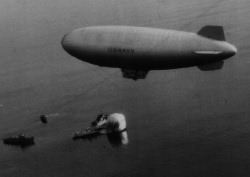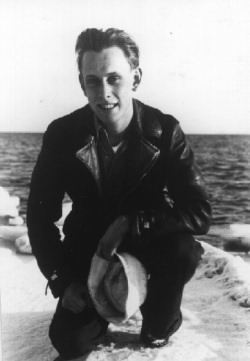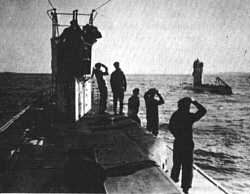| Type XIB Uboat From "Sub Sea Recovery: CA-35" |
||||
|
By the 18th. British Admiralty admitted to U.S. "COMINCH" that the heading of "LT", (Love Tare), "REMAINS OPEN", suggesting that all are totally confused as to the subject vessel's actual destination and purpose. Then on 20 August the U-1229 was successfully sunk by U.S. Naval forces just east of the Grand Banks, as stated within the "ULTRA" radio-intercept transmission, as follows: "TWO OFFICERS AND ONE PROPAGANDIST AMONG 41 P/S FROM LOVE EASY x C.O. LOST x YOUR 1279 PARA 4 x LOVE TARE HEADING BAFFLING BUT BEST GUESS IS HE IS APPROACHING ST JOHNS AREA x THIS CONSISTENT WITH AMERICA II..."
Again, on the 21st. U.S. "COMINCH" requested further information from the British Admiralty concerning the unknown U-Boat in question by stating:
After comparing all of the pertinent documents to the numerous other operational intelligence material it becomes obvious that the "ULTRA" staff are completely unaware of the actual mission of the Type XI-B U-Cruiser, whereas certain other intelligence operatives are totally aware of the facts. This is a typical example of "need to know" restrictions between intelligence departments.
 By the early evening of the 25th. the Type XI was successful in evading the U.S. Naval Task Forces east of the Grand Banks, as she surfaces at approximately 1600 hours. Due to a sighting by a commercial Pan-Am Plane at this time, the Naval Airship Squadron 'ZP-11' based at South Weymouth, MA orders the Naval Airship "K-25" to divert from its escort patrol and to investigate the reported sighting. Local vessels of the Northern Ship Lane Patrol are also ordered to the scene. At this same time O.N.I. Telegrapher Preston Howley was monitoring the U-Boat's wireless transmission from the Office of Naval Intelligence Radio Intercept Station located at Chatham, Cape Cod. According to Howley, the transmission was originating from a very close location on a 'diplomatic B-Bar' signal. This meant that this particular German U-Boat was sending diplomatic messages in a "High Priority" status, which fits the established facts. The total message lasted perhaps twenty minutes, enough to fill three legal-size teletype pages of coding data. O.N.I. Telegrapher Howley duly re-transmitted this message over his teletype to the U.S. Naval Cryptographic Center in Washington, D.C. Within half an hour the message bounced back to his station from Washington with the statement that they wished him to verify the coding and destination address, which he did.
 Howley verified the coding and address which he firmly believes was destined for the White House Map Room. The White House Map Room was not just the President's War Room, but was also an intelligence center for combined services - managed by the Department of State itself. The implications of Howley's experiences and later assessments are obvious. The following operations, which lasted over two days, are code named "OBSCURE CINCH" and "LADY BULL". According to the 'Official' record these "Special Searches" resulted in no activity and no confirmation of any subsequent action at the scene. The fact that these operations occurred at exactly the same location as the present location of the wreckage of the Type XI-B discovered in 1993, however, is significant. Veteran interviews have revealed that the subject U-Boat was actually sunk by the Naval Airship "K-25", with the small surface vessels conducting a 48 hour surface search for survivors and debris. The official records certainly tend to support the follow-up search for debris, often termed as a "Yankee Search". Unfortunately, only a further declassification of existing "Operational" documents would provide additional insight into exactly what happened and how it happened. |
IN SEARCH OF A GHOST The first hint of the existence of a U-Boat wreck off Cape Cod occurred in 1988, when now Trident President Edward Michaud heard for the first time the accepted stories of its demise off the Cape from a local tug-boat skipper named Warren LeGyte. Michaud had been running a sixty-one foot crew-boat out of Boston for the then ongoing MWRA Outfall Project. Every night Michaud and his fellow crewmen would bunk in Warrens 100 foot tug "Georgina A", then tied up at one of the East Boston docks. Since hearing of the legendary U-Boat, Ed would query Warren of what he knew of the vessel and its location. In due time the MWRA contracts would end and Michaud would eventually locate the various veterans who were involved in the original 1944 incident. By June of 1993 Michaud had joined up with several dedicated professionals in an attempt to re-locate the legendary Cape Cod U-Boat and on the 5th. of that month the first hazy side scan sonar images of the wreckage were obtained. Equipment and financing, however, were slow in coming and it was 9 December of 1993 before any detailed sonar images of the wreck could be obtained. Upon the initial discovery in June it was assumed by all involved in the project that the U-Boat located off Cape Cod was a standard German Type IX-C/40 submarine on a routine war patrol at the time of its loss. However, when the detailed sonar images were obtained in December it was immediately apparent that what had been found was much larger in both length and bulk. After weeks of study and comparisons with known German building plans it became obvious that what had been found was actually a submarine that, according to all known histories, was not supposed to exist! Michaud and his team had found a German Type XI-B U-Cruiser - in and of itself a major discovery. By November of 1994 the first detailed sonar imagery of the Type XI armored gun-mounts were obtained utilizing E.G.&G sonar equipment. This left little doubt as to the vessel's structural confirmation. The wreck was heavily encased in huge drifts of sand ledges, as is to be expected in the area. As an example, just several miles to the west the 325 foot long wreckage of the steam-freighter "Dixie Sword" is almost completely covered in the same pattern of sand disposition. In March of 1995 Michaud and his group incorporated as Trident Research & Recovery, Inc. and by June the new company had filed for, and received, exclusive rights of salvage for the German Type XI-B U-Boat in the First Federal District Court in Boston. Under this Admiralty claim, Civil Action No. 95-11374RCL, Trident continued its survey of the site. An Archaeologist was added to the survey team to ensure proper methodology in the project. Additional Archivists and Researchers were consulted and the process of discovery continued both in the Archival repositories and on the site of the wreck itself. TODAY As of August, 1997 Trident Research & Recovery, Inc. and Sub-Sea Recovery, Inc. of Portland, Maine combined their resources in order to bring the latter's experience, expertise and high technology ability to bear on the Project. Trident and Sub-Sea had been working jointly on other interesting research projects in the recent past, so it seemed only natural to combine the resources of both companies on the "Operation CA-35" Project. All vessel artifacts so recovered are slated for preservation and ultimate public display at the U.S.S. Salem Museum located in Quincy, Massachusetts. Needless to say, this should make for a rather impressive and informative stage for further public dissemination. It should be noted that Trident has attempted on many occasions to open a dialogue with the respective offices of the U.S. Department of State, the Federal Republic of Germany and the U.S. Department of the Navy. All such requests for open discussion have been ignored. Several Senators and Congressmen have been notified by Trident in an attempt to both open such dialogues and assist in further investigations into the original 1944 incident. We at Trident and Sub-Sea believe that there will probably be more developments in this area as the Project moves forward. As an additional note, if all of those very fine authors listed in Section "C" of the following Source Citations had been aware of the existence and deployment of the German Type XI-B there is no doubt that they too would have put the pieces together! Apparently, the missing link was the Type XI. Go to Page 4
|
|||
|
© 1997 - 2000 COMBATSIM.COM, INC. All Rights Reserved. Last Updated February 17th, 1999 |
||||

